The topic of this article may not meet Wikipedia's notability guideline for biographies .(April 2020) |
Hilary J. Crichton is a British chemist currently the Editor-in-Chief of Biopolymers . [1] [2] [3] [4]
The topic of this article may not meet Wikipedia's notability guideline for biographies .(April 2020) |
Hilary J. Crichton is a British chemist currently the Editor-in-Chief of Biopolymers . [1] [2] [3] [4]

Biopolymers are natural polymers produced by the cells of living organisms. Like other polymers, biopolymers consist of monomeric units that are covalently bonded in chains to form larger molecules. There are three main classes of biopolymers, classified according to the monomers used and the structure of the biopolymer formed: polynucleotides, polypeptides, and polysaccharides. The Polynucleotides, RNA and DNA, are long polymers of nucleotides. Polypeptides include proteins and shorter polymers of amino acids; some major examples include collagen, actin, and fibrin. Polysaccharides are linear or branched chains of sugar carbohydrates; examples include starch, cellulose, and alginate. Other examples of biopolymers include natural rubbers, suberin and lignin, cutin and cutan, melanin, and polyhydroxyalkanoates (PHAs).

In organic chemistry, a peptide bond is an amide type of covalent chemical bond linking two consecutive alpha-amino acids from C1 of one alpha-amino acid and N2 of another, along a peptide or protein chain.
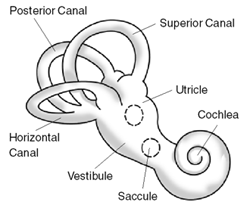
Ménière's disease (MD) is a disease of the inner ear that is characterized by potentially severe and incapacitating episodes of vertigo, tinnitus, hearing loss, and a feeling of fullness in the ear. Typically, only one ear is affected initially, but over time, both ears may become involved. Episodes generally last from 20 minutes to a few hours. The time between episodes varies. The hearing loss and ringing in the ears can become constant over time.

Lavender oil is an essential oil obtained by distillation from the flower spikes of certain species of lavender. There are over 400 types of lavender worldwide with different scents and qualities. Two forms of lavender oil are distinguished, lavender flower oil, a colorless oil, insoluble in water, having a density of 0.885 g/mL; and lavender spike oil, a distillate from the herb Lavandula latifolia, having a density of 0.905 g/mL. Like all essential oils, it is not a pure compound; it is a complex mixture of phytochemicals, including linalool and linalyl acetate.

An ionic liquid (IL) is a salt in the liquid state at ambient conditions. In some contexts, the term has been restricted to salts whose melting point is below a specific temperature, such as 100 °C (212 °F). While ordinary liquids such as water and gasoline are predominantly made of electrically neutral molecules, ionic liquids are largely made of ions. These substances are variously called liquid electrolytes, ionic melts, ionic fluids, fused salts, liquid salts, or ionic glasses.

Dermatofibrosarcoma protuberans (DFSP) is a rare locally aggressive malignant cutaneous soft-tissue sarcoma. DFSP develops in the connective tissue cells in the middle layer of the skin (dermis). Estimates of the overall occurrence of DFSP in the United States are 0.8 to 4.5 cases per million persons per year. In the United States, DFSP accounts for between 1 and 6 percent of all soft-tissue sarcomas and 18 percent of all cutaneous soft-tissue sarcomas. In the Surveillance, Epidemiology and End Results (SEER) tumor registry from 1992 through 2004, DFSP was second only to Kaposi sarcoma.

Fibrils are structural biological materials found in nearly all living organisms. Not to be confused with fibers or filaments, fibrils tend to have diameters ranging from 10 to 100 nanometers. Fibrils are not usually found alone but rather are parts of greater hierarchical structures commonly found in biological systems. Due to the prevalence of fibrils in biological systems, their study is of great importance in the fields of microbiology, biomechanics, and materials science.
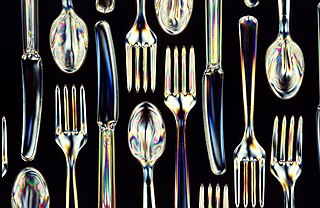
Bioplastics are plastic materials produced from renewable biomass sources, such as vegetable fats and oils, corn starch, straw, woodchips, sawdust, recycled food waste, etc. Some bioplastics are obtained by processing directly from natural biopolymers including polysaccharides and proteins, while others are chemically synthesised from sugar derivatives and lipids from either plants or animals, or biologically generated by fermentation of sugars or lipids. In contrast, common plastics, such as fossil-fuel plastics are derived from petroleum or natural gas.

2-Aminoisobutyric acid (also known as α-aminoisobutyric acid, AIB, α-methylalanine, or 2-methylalanine) is the non-proteinogenic amino acid with the structural formula H2N-C(CH3)2-COOH. It is rare in nature, having been only found in meteorites, and some antibiotics of fungal origin, such as alamethicin and some lantibiotics.
Blepharospasm is a neurological disorder characterized by intermittent, involuntary spasms and contractions of the orbicularis oculi (eyelid) muscles around both eyes. These result in abnormal twitching or blinking, and in the extreme, sustained eyelid closure resulting in functional blindness.
A turn is an element of secondary structure in proteins where the polypeptide chain reverses its overall direction.
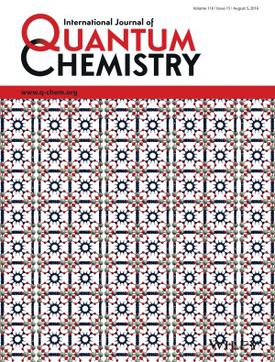
The International Journal of Quantum Chemistry is a peer-reviewed scientific journal publishing original, primary research and review articles on all aspects of quantum chemistry, including an expanded scope focusing on aspects of materials science, biochemistry, biophysics, quantum physics, quantum information theory, etc.

The Journal of Raman Spectroscopy is a monthly peer-reviewed scientific journal covering all aspects of Raman spectroscopy, including Higher Order Processes, and Brillouin and Rayleigh scattering. It was established in 1973 and is published by John Wiley & Sons. The editor-in-chief is Laurence A. Nafie.

Neuropeptide Y receptor type 1 is a protein that in humans is encoded by the NPY1R gene.

7-Spiroindanyloxymorphone (SIOM) is a drug that is used in scientific research. It is a selective δ-opioid agonist. It is a derivative of oxymorphone.
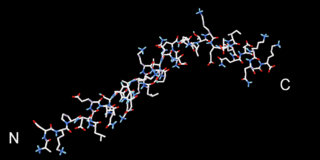
Beta thymosins are a family of proteins which have in common a sequence of about 40 amino acids similar to the small protein thymosin β4. They are found almost exclusively in multicellular animals. Thymosin β4 was originally obtained from the thymus in company with several other small proteins which although named collectively "thymosins" are now known to be structurally and genetically unrelated and present in many different animal tissues.
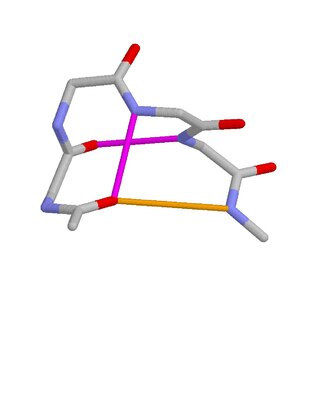
Schellman loops are commonly occurring structural features of proteins and polypeptides. Each has six amino acid residues with two specific inter-mainchain hydrogen bonds and a characteristic main chain dihedral angle conformation. The CO group of residue i is hydrogen-bonded to the NH of residue i+5, and the CO group of residue i+1 is hydrogen-bonded to the NH of residue i+4. Residues i+1, i+2, and i+3 have negative φ (phi) angle values and the phi value of residue i+4 is positive. Schellman loops incorporate a three amino acid residue RL nest, in which three mainchain NH groups form a concavity for hydrogen bonding to carbonyl oxygens. About 2.5% of amino acids in proteins belong to Schellman loops. Two websites are available for examining small motifs in proteins, Motivated Proteins: ; or PDBeMotif:.
Biopolymers is a biweekly peer-reviewed scientific journal covering the study of biopolymers from a biochemical and biophysical perspective. It was established in 1963 and is published by John Wiley & Sons. The editor-in-chief is Hilary J. Crichton. The journal has three sections: Peptide Science, Nucleic Acid Sciences, and Biospectroscopy. Peptide Science is the affiliate journal of the American Peptide Society. According to the Journal Citation Reports, the journal has a 2015 impact factor of 2.248, ranking it 39th out of 72 journals in the category "Biophysics" and 186th out of 289 in the category "Biochemistry & Molecular Biology".
Synthetic biopolymers are human-made copies of biopolymers obtained by abiotic chemical routes. Synthetic biopolymer of different chemical nature have been obtained, including polysaccharides, glycoproteins, peptides and proteins, polyhydroxoalkanoates, polyisoprenes.

Nina D. Berova is a Professor of Chemistry at Columbia University. She is recognised as a world leader in stereochemistry and chiroptical spectroscopy. Her contributions include the development of porphyrin tweezers. She was the 2007 winner of the Società Chimica Italiana Chirality Medal.